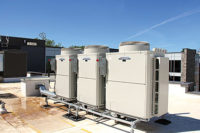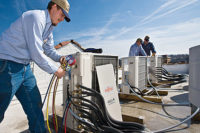It’s no secret that many school districts across the country lack funding for buildings repairs and desperately need to upgrade their facilities. While some administrators put off HVAC projects for as long as they can, choosing to repair instead of replace antiquated equipment, others are looking for ways to save energy and money in the long run while operating as green and sustainably as possible. The following case studies illustrate how schools across the country are implementing different HVACR solutions to achieve these goals.
SOUTH HIGH COMMUNITY SCHOOL
After numerous water leaks, compressor failures, and damper control problems, it was time for South High Community School in Worcester, Massachusetts, to replace its 30-year-old rooftop units. Not only had the units outlasted their expected mechanical life cycles, but their ability to deliver fresh outdoor air and maintain comfortable heating and cooling conditions became increasingly difficult and expensive. To specify a state-of-the-art replacement HVAC rooftop system, the energy- and environmentally conscious school district enlisted the services of Springfield, Missouri-based Lindgren & Sharples P.C. Director of facilities Jeff Lassey met with Lindgren & Sharples engineer Mike Lescarbeau to establish new system design requirements. Electric heat would need to be replaced with a lower-cost energy source. To avoid altering the recently installed rubber roof, the new replacement units would need to utilize existing roof curbs and ductwork.
Because the replacement units would also be supplying outdoor air to meet the school’s IAQ requirements, Lassey wanted to include energy recovery ventilation (ERV) technology to minimize the energy load. Lescarbeau specified a total of 19 gas/electric rooftop units with integrated Airxchange Inc. energy recovery wheels to replace the all-electric units. Systems utilizing Airxchange wheels recover up to 80 percent of the energy in exhaust air to heat, cool, dehumidify, or humidify a like amount of incoming fresh air. This can reduce HVAC design loads and annual energy use by as much as 50 percent.
By using the ERVs, Lescarbeau was able to specify smaller, lower-cost heating and cooling units to easily fit within the existing roof curb profile. Adaptor curbs were designed and fabricated by a local curb supplier to fit the new rooftop units to the existing curbs. Direct digital controls and modulating dampers were added for individual zone control through an existing building automation system.
Airxchange energy recovery wheels were calculated to save South Community High School approximately $60,000 annually. The initial added investment in wheel-based rooftop units is expected to be recouped during the first year of operation based on savings from the Airxchange wheels alone. Had the school not converted its heating energy source from electric to gas, the wheels would have provided an additional $100,000 annually in outdoor air energy savings.
“For roughly the same price as a larger, more energy-intensive rooftop unit, we can provide the same amount of work with a smaller, wheel-based unit that performs with up to 40 percent greater efficiency,” said Craig Campbell, Trumbull and Campbell Associates. “This translates to significant energy savings over the life of the equipment.”
The replacement HVAC rooftop system earned South High Community School a Central Mass Green Award for energy efficiency. The award was created by the Worcester Business Journal (WBJ) to recognize organizations “going the extra mile” to make green choices. South High’s energy recovery wheels are estimated to reduce CO2 emissions by 265 tons annually, which translates to approximately 353 pounds per student.
RIVERSIDE MILITARY ACADEMY
The Riverside Military Academy preparatory school in Gainesville, Georgia, is home to 460 cadets and a 206-acre campus featuring dormitories, classrooms, a fine arts and performing arts center, dining hall, library, gymnasium, Olympic-size swimming pool, lighted athletic fields, and annual utility bills approaching $1 million.
Danfoss consultant Robert Eidson, an active member of Riverside’s Board of Visitors and father of a Riverside alumnus, took a special interest in the school’s struggles with its utility costs. He collaborated with Larry Robinson, facilities director at Riverside, to identify where energy was being used and formulated a plan to reduce consumption. The installation of the Danfoss AK-SC 255 system controller was critical to their plan.
The first step for Riverside was identifying its largest load consumer, which turned out to be the barracks dormitory. Before the installation, room temperatures could be set as low as 60°F and as high as 80°; today, that range has been reduced by 10 degrees, limiting excessive energy use while maintaining comfort and supporting energy savings.
Using the Danfoss system controller, they detected another large consumer: the Olympic-size swimming pool, which holds nearly 1 million gallons of water. The pool’s motor typically ran at 100 percent 24/7. To reduce energy use, Riverside installed a Danfoss AKD-102 drive that allows the motor to slow down and speed up, as opposed to running constantly.
“Who is swimming at 2 a.m.? Nobody,” Robinson said. “Why did we need to run that motor 24/7? We didn’t.”
The Danfoss system controller also identified campus outdoor lighting as another large consumer. The dining hall contributed to high maintenance costs due to the daily light bulb replacements in its 600-bulb ceiling. An $8,000 lighting upgrade included the installation of more than 300 LED lights, which reduced energy usage as well as maintenance costs.
Since the installation of the Danfoss controller, energy meters, lighting controls, and variable-speed drive, Riverside has experienced a 27 percent decrease in its annual energy consumption and a 5,817,654 kWh reduction over the past five years. Both Eidson and Robinson directly attribute this to the use of the Danfoss AK-SC 255 system controller.
“By installing these components, Riverside now is able to monitor individual buildings from any computer,” Eidson said. “Because of this, when the academy goes through a variety of tasks — such as light bulb replacements, adding variable-speed drives, or load shifting — they can view the direct results of our efforts through the Danfoss controller.”
“In fiscal year 2011-2012, our electricity expense was $416,000,” Robinson said. “This past year, we experienced increased enrollment, which required opening previously closed areas of
the dorm. Taking this into account, along with a 26 percent increase in electricity rates, I still only budgeted $389,500 for our electricity expense. This reduced budget and the savings it
represents is a result of some of the proven changes we’ve been able to implement through a Danfoss solution.”
CEDAR RIDGE HIGH SCHOOL
Round Rock Independent School District envisioned a sleek, modern new campus that would foster the growth and development of its students. Administrators wanted a high school capable of unlocking the hidden abilities of their students and aiding teachers in preparing students for the next chapter of their lives. Cedar Ridge High School is the result.
Cedar Ridge High School in Round Rock, Texas, is a unique, two-story, 375,000-square-foot high school divided into four distinct academies: Academy of International Business and Economics; Academy of Professional Studies; Academy of Science, Technology, Engineering, and Mathematics; and the Academy of Visual and Performing Arts. Each academy houses its own media center, administration suites, and planning areas for teachers. The common areas for all students are the cafeteria, the athletic facility, and the outdoor courtyard, which is considered the heart of campus and is home to several multipurpose events.
The design team and Round Rock ISD wanted this school to be an environmentally friendly facility. The school is Leadership in Energy and Environmental Design (LEED)-certified and features several sustainable elements. It uses local limestone materials on the exterior of the buildings and offers an abundance of natural light. All the windows allow natural light to penetrate deep into the occupied spaces.
The HVAC system featured in the high school also contributed to it achieving LEED certification. Several areas in the new high school utilize displacement ventilation, which is a unique alternative for air distribution. The project utilized Titus HVAC’s products, including the DVIR unidirectional discharge diffuser designed for flush-mount applications and the DVBC rectangular displacement diffuser, which has a curved face and discharges air via a three-way pattern. Both units provide air distribution by supplying large volumes of air at low velocities into the occupied zone. Easily adjustable air pattern controllers inside the units can create different airflow patterns in the space to optimize occupant comfort.
The Titus TMSA steel diffuser was also utilized and features adjustable vanes that vary between vertical and horizontal discharge patterns for heating and cooling applications. These diffusers deliver supply air in a 360-degree pattern and are designed to protect ceilings from smudging. All sizes have three cones providing a uniform appearance. The TRM aluminum mounting frame was used to make installation of the grilles, diffusers, and other ceiling components in plaster and sheet rock ceilings as simple as inserting them in a standard T-bar-type ceiling. For typical applications, the frame has adjustable fastening clips, which adapt to a variety of plaster and sheet rock ceiling thicknesses.
There have been numerous studies on the importance of proper ventilation in schools. Cedar Ridge High School has a state-of-the-art HVAC system that provides superior performance for its students and faculty. The new high school is also a beautiful campus that has created the best learning environment for the students of Round Rock, Texas.
BELMONT UNIVERSITY
With booming enrollment and an aggressive campus expansion plan, officials at Belmont University realized that standardizing building equipment, controls, and service would help promote efficiency, cost savings, and easier day-to-day operation of its buildings.
Located just southwest of Nashville, Tennessee, Belmont more than doubled its enrollment in 15 years and grew to a 50-building complex with 3 million square feet of space — up from 2 million square feet since the expansion began. As a result, the mix of historic buildings and new facilities meant the university was utilizing a variety of HVAC systems and building controls.
With multiple HVAC suppliers and service providers, the systems lacked interconnectivity, making it difficult for facilities staff to operate the systems efficiently. Knowing the expansion would continue for several years, Belmont sought a single-platform, multifaceted solution to help control energy and operational costs and promote efficiency.
The university chose a Trane® Tracer™ ES enterprise control system upgrade and restructured the university building automation system (BAS) operating interface. Belmont also established Trane as the sole-source supplier for the standardization of equipment, controls, and support service. The results: Even after increasing the campus footprint by 45 percent, Belmont saw just a 5 percent increase in energy use, and the university’s kilowatt hour usage rate per square foot decreased from 16.3 in 2011 to 12.5 in 2015. The local utility company even double checked the campus meters because the actual energy use didn’t correlate with the typical increase when considering the amount of added space.
Belmont also added advanced BAS technologies and upgraded submeters and equipment. With the BAS system, Belmont facility managers perform daily operations and status updates and have the flexibility to quickly make scheduling adjustments across campus for holidays and breaks — or in specific buildings during special events. The BAS offers convenient remote access, so staff can manage system performance from Web-enabled PCs, tablets, and smartphones.
The university also installed Trane Tracer™ SC system controllers in both newly constructed and renovated buildings to allow building operations staff to program and control facility climate. The system provides easy scheduling, reporting, and system application tasks, which helps increase energy efficiency, staff productivity time, and occupant comfort in campus buildings.
Because many of Belmont’s utilities are installed underground, a key component of the project was adding new smart submeters to monitor energy use. The submeters were integrated, along with new and previously installed Trane controllers and third-party systems, through the Tracer ES system, allowing Belmont staff to manage all campus buildings as a single enterprise.
The integrated control system lets Belmont realize visibility to energy use across the campus, enable proactive cost management, and make better and more efficient operational decisions.
PARIS COOPERATIVE HIGH SCHOOL
Western Specialty Contractors recently applied a fluid membrane air barrier to the 130,000-square-foot Paris Cooperative High School (PCHS) under construction in Paris, Illinois. Western’s work is slated to be certified by the Air Barrier Association of America (ABAA), which requires extensive installer training, installation testing, and an auditor inspection.
Over time, air leakage in a building can contribute to IAQ issues, increased energy costs, mold growth, efflorescence, and degradation of a building’s structure. Ensuring that the air barrier is applied properly during construction is crucial to the life of the building and to the wellbeing of its occupants.
Western crews began work on the two-month project in May 2014. The majority of the new two-story school’s exterior is constructed of steel studs and exterior-grade drywall along with some concrete masonry units (CMU). Western crews sealed all seams in the exterior sheeting after taping all corners, control joints, and wood blocking. Once all of the prep work was completed, Western crews applied 8 wet milliiltres of W.R. Meadows AIR-SHIELD LSR to the entire wall surface. W.R. Meadows products are manufactured in Illinois, which contributes to the facility’s LEED accreditation.
Western crews faced, and resolved, several challenges throughout the project to stay on schedule and within budget. “One of those challenges included access to some areas due to wet weather conditions,” said Darren Lemon, project manager, Western Specialty Contractors. “Extreme mud made it difficult to get equipment moved in and out. We also had to make sure to keep ahead of the mason contractors so their work could keep flowing. Two separate mason contractors were hired on the project to install masonry veneer and back-up walls. The challenge was adjoining our air barrier where the other mason contractors had applied their own air barriers. Another challenge was the window and door openings along with the columns, which had extensive wood blocking on them. Taping all of the angle changes on such a large structure was challenging and time-consuming.”
The new $40 million high school, sports fields, and track will replace the existing high school. It sits on more than 65 acres that will also include a 500-space parking lot and 500-seat theatre. The renovated Paris Cooperative High School is expected to open later this month.
Publication date: 8/3/2015
Want more HVAC industry news and information? Join The NEWS on Facebook, Twitter, and LinkedIn today!












